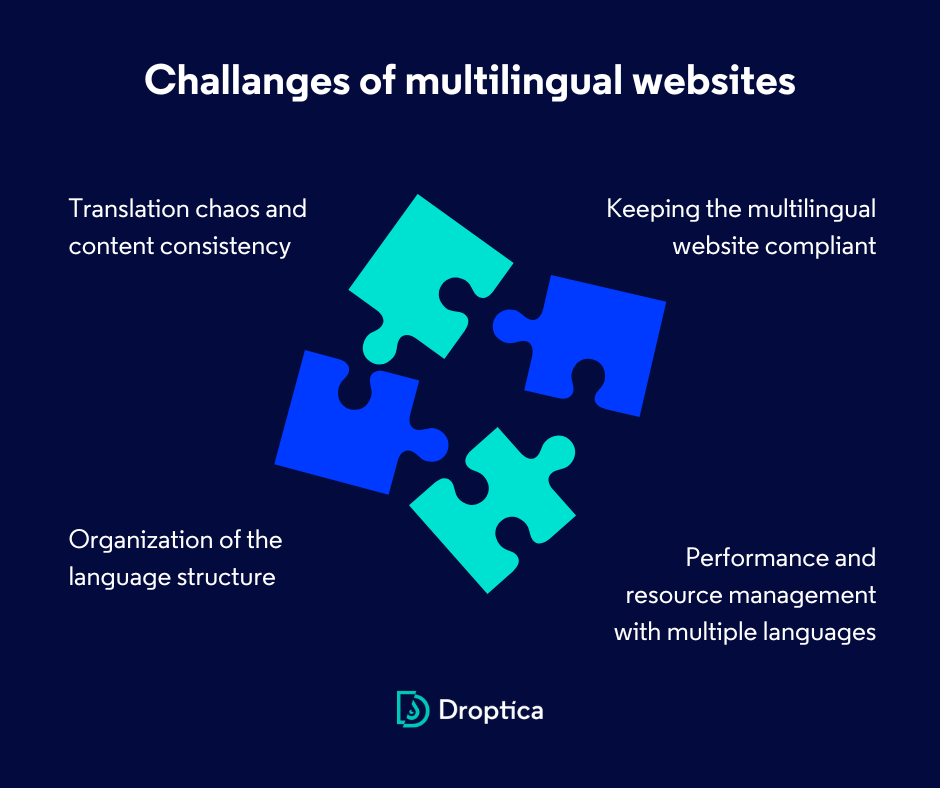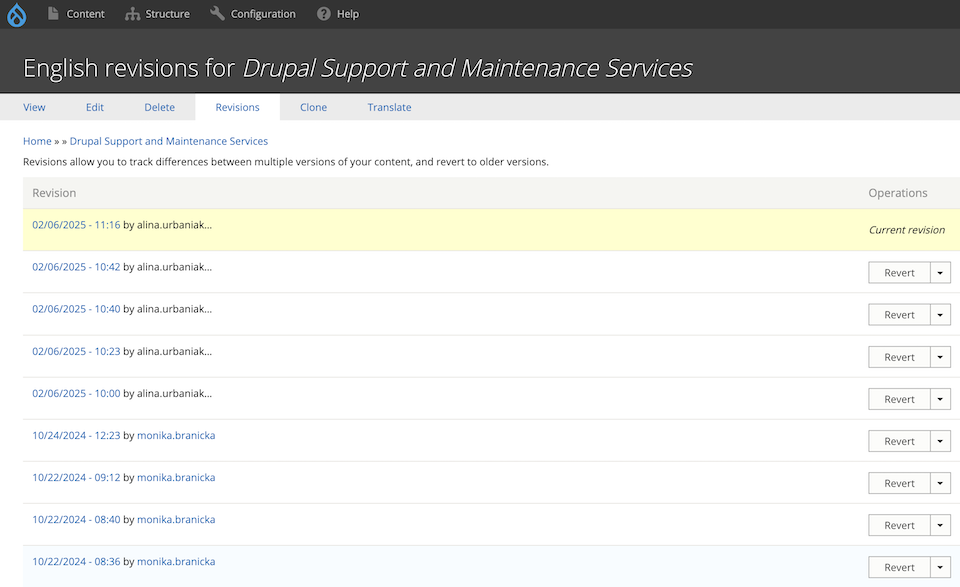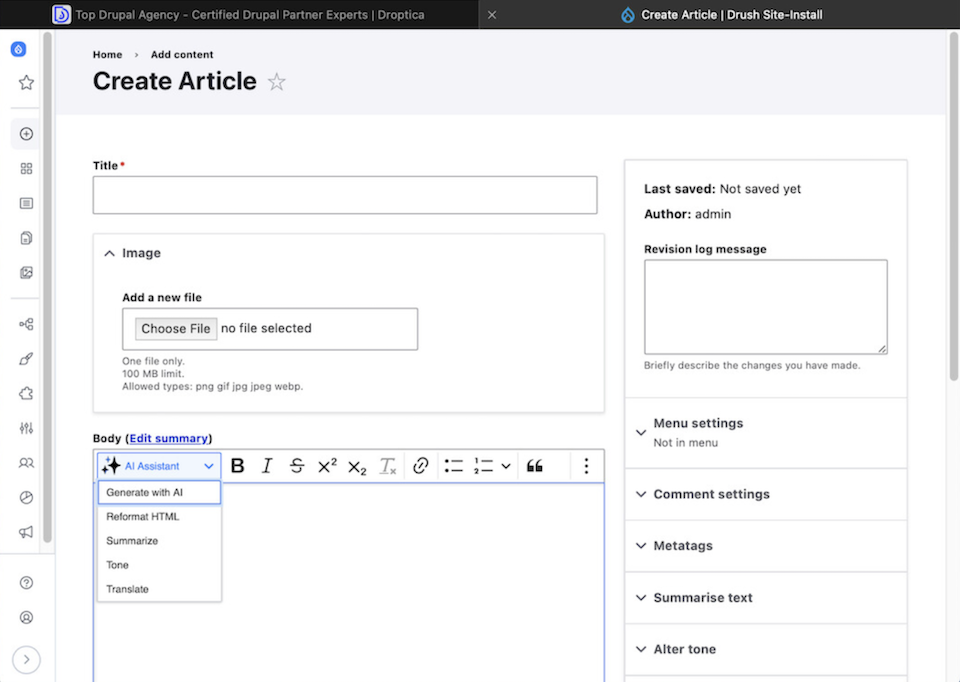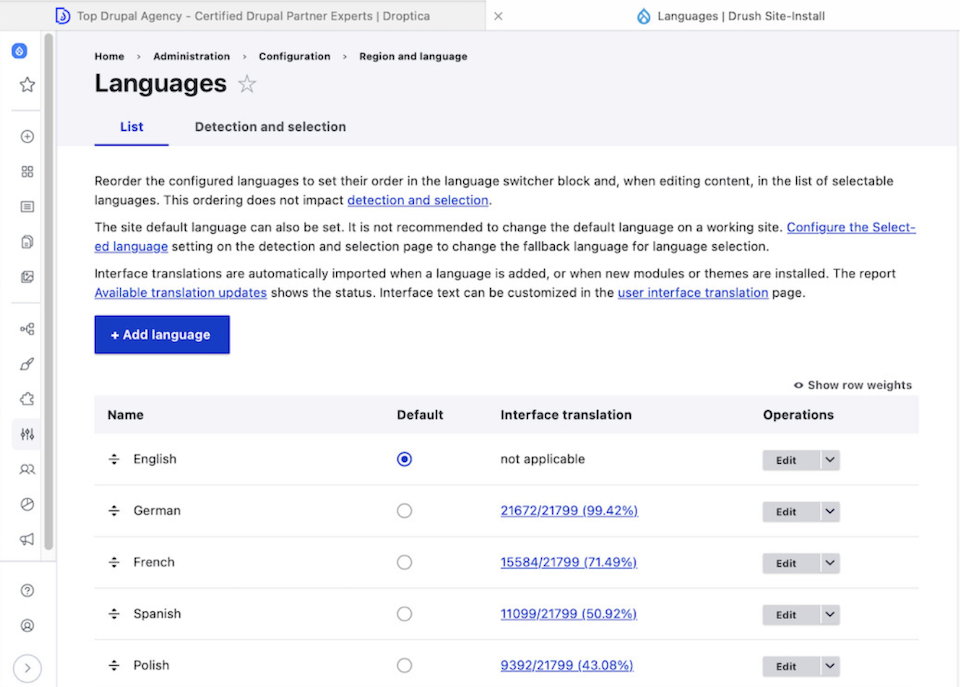
How to Control the Chaos on a Multilingual Website With a CMS? Best Practices
A multilingual website is a huge opportunity to reach an international audience, but without proper organization, it can quickly become a source of chaos. Problems with website translations, inconsistent content, or managing various language versions can lead to user confusion and loss of potential customers. In this article, we'll show you how to effectively manage a multilingual website with a CMS.
In this article:
- Challenges in managing a multilingual website
- Essential CMS functionality to support multilingualism
- Practical approaches to organizing content on a multilingual website
- How does Drupal support multilingual website management?
Challenges in managing a multilingual website
As the number of languages and the content base of a web page grows, so does the complexity of managing such a project. Companies face the challenges of coordinating translations, maintaining consistent communication, and ensuring that each language variant (whether it's a foreign or native language) is correct and error-free. Below are the most critical issues that arise when running a multilingual website on any CMS.

Translation chaos and content consistency
One of the biggest risks is the discrepancy between the different language versions of the website. If content isn't translated consistently and updates aren't systematic, it's easy to have differences in messaging and inconsistent branding. These can lead to:
- Linguistic errors and ambiguities - poorly translated communications not only create an impression of unprofessionalism but can also mislead users.
- Outdated information - if one language variant is updated more often than another, visitors receive different messages, which reduces the website's credibility.
- Difficulties maintaining quality - the lack of clearly defined translation standards or control processes (e.g., verification of translations before publication) results in more difficult management and lower-quality content.
As a result, even with a lot of effort, the company may not achieve its goals of expanding into foreign markets. Maintaining consistency in communications, therefore, requires meticulous planning and constant monitoring of all language variants.
Organization of the language structure
Another challenge is to design a clear and intuitive website structure that considers diverse language versions. This applies to both navigation elements and the way you present the content:
- Menu and URL logic - users expect to find content in their preferred language easily and immediately. Improperly configured page hierarchies or unreadable URLs lead to confusion for website visitors.
- Complex category hierarchy - as more languages are added, the number of categories and subpages grows, which requires a well-thought-out information architecture so that the user doesn't get lost in the website's structure.
- Consistent naming - standardized category and section names across languages make it easier to navigate and translate into a positive user experience (UX).
Improper organization of the language structure makes it less user-friendly and more difficult to manage from the editorial side. Every publication or update requires finding the right section, and with a lack of clarity, it's easy to change the wrong language option.
Keeping the multilingual website compliant
Multilingual services, especially those targeting audiences from different countries, must meet various legal requirements and standards. Among the significant challenges in this context are:
- WCAG (Web Content Accessibility Guidelines) - adapting a website for users with disabilities should apply to every language variant, and sometimes this requires additional testing and changes (such as adjusting alternative descriptions for visual content).
- Privacy regulations (e.g., GDPR) - the cookie policy and data protection rules must be translated and aligned with your country's regulations.
- Other specific legal requirements - depending on the region, there may be additional regulations for e-commerce, cross-border sales or online service provision.
Violation of these regulations can lead to financial penalties, image damage, and restricted access to markets. That's why it's so important that every language variant of a multilingual website is carefully checked against local regulations.
Performance and resource management in various languages
Each successive language version means new content, media files, and additional system configurations, which can put a significant strain on the performance. Key areas requiring attention are:
- Server load - an extensive database, files, and complex web architecture can degrade the page speed, negatively affecting user experience.
- Disk space management - a multilingual site needs to store materials (e.g., images, documents) in different language variants, which increases the demand for disk space.
- Optimization of resources - it's necessary to implement caching mechanisms, data compression, or appropriate configuration of CDN (Content Delivery Network) to effectively handle traffic from different regions of the world.
- Administrative costs - updating and maintaining consistent content in all languages requires additional human resources and labor for ongoing coordination.
Failure to take a comprehensive approach to optimizing the website and organizing processes can result in bottlenecks in the page's operation - both in terms of performance and transparency for editors or company management.
Essential CMS functionality to support multilingualism
Choosing the right CMS platform can make running a multilingual site dramatically easier or harder. Extensive tools and mechanisms for managing translated content, automating processes, and customizing the website for different audiences are the key to international success. Below are the most important functionalities to consider when planning or developing a multilingual website.
Content management in multiple languages
One of the cornerstones of a multilingual CMS is the ability to intuitively and comprehensively manage the translation of individual page elements. Modern platforms offer, among other things:
- Translation fields - dedicated areas in the editor that allow you to add content in different language options in one place. This makes it easier to view all variants of a given text and speeds up the editing process.
- Clear content separation - a well-designed CMS makes it possible to separate content common to all language variants (e.g., layout elements) from those that need to be submitted for translation. This helps reduce chaos and makes the admin panel easier to navigate.
- Versioning - tracking and saving changes allows you to quickly restore earlier versions and facilitates the cooperation of many people (e.g. editors, translators). This avoids the situation where you mistakenly overwrite important information.

Revision view for an English web page on Drupal
Automation of translation processes and CMS integration with external tools
Each language version means additional work to translate and update the content. To streamline this process, many CMS systems offer:
- Integrations with translation tools - thanks to built-in modules or plugins, you can automate the submission of content to external translation providers (e.g. Google Translate or DeepL). Just click the appropriate button to submit the content for translation and get a ready-made language variant to import into the CMS.
- Automatic synchronization - making changes to the original version can automatically trigger translation update processes, so the editor doesn't have to remember to complete a section on the page each time.
- Workflow rules - systems can support advanced content creation workflow scenarios, such as reviewing a translation by a designated specialist or automatically notifying when a batch of text needs to be updated.
AI features to support multilingual websites
AI development is making automatic translations more accurate and linguistically natural. In the context of CMS, artificial intelligence can be used in many ways:
- Automatic translation proposals - machine learning-based tools offer initial translations that can be quickly reviewed and corrected by a human. This allows for significantly speeding up the content publishing process.
- Language analysis and style suggestions - some systems can point out excessively long sentences, colloquial phrases or unclear expressions, supporting the creation of understandable and correct texts in all languages.
- Personalizing content - smart algorithms can automatically recommend content tailored to a user's preferences and browsing history, resulting in better engagement with target audiences from different locations.

Example of an AI assistant for content creation and translation in Drupal
Flexible language settings for different markets
Not all markets will need exactly the same content or identical page layouts. That's why the following are so important:
- Various formats of dates, currencies and measures - many CMS providers offer modules that allow customization of local data presentation standards (e.g., date format, number spelling, currency used).
- Ability to activate/deactivate language - in case the company's strategy is to withdraw from a specific market or temporarily stop publishing in a particular language, it's good to be able to easily disable the display of content.
- Web content personalization for selected regions - sometimes language alone is not enough. Adapting offers, prices, terms, and conditions, or marketing materials to the specifics of a particular country can make the difference in the success of a given campaign.
Mechanisms for detecting user's language preferences
To make the use of a multilingual website as simple as possible, it's a good idea to provide functionalities that automatically adapt the language variant to the needs of visitors:
- Geolocation - CMS can suggest the appropriate language option to the user based on the IP address or browser settings, while retaining the ability to manually select a different language using, for example, a convenient switch.
- Browser header analysis (Accept-Language) - this is a simpler mechanism that allows content to be displayed in the language set by default in the browser. This is often the first step to a personalized experience for the visitor.
- Remembering the choice - once selected, the language version should be remembered in cookies or in the user's session, so that when the user returns to the site, he or she does not have to make the choice again.

Example of language switcher for English and Polish on Droptica web page
Practical approaches to organizing content on a multilingual website
Successfully managing content in multiple languages requires not only the right tools but also a well-thought-out strategy and clear processes. Whether a company has an extensive marketing department or uses outsourced translation, it's worth looking at different workflow concepts.
It's a good idea to implement solutions that minimize the risk of chaos and inconsistency in communication. Below, we discuss the most important aspects to consider when planning and maintaining a successful multilingual website.
Centralization vs. decentralization of content management
The basic question is whether to manage multiple language versions in a centralized or distributed manner across different teams or departments:
- Centralization
- Advantages: Possibility of strict quality control, unified translation standards, and easier development of a consistent image. Reduced risk of duplicate work and discrepancies.
- Disadvantages: Greater burden on one department or group of people, limited flexibility (e.g., more difficult to respond to the specifics of a particular market).
- Decentralization
- Advantages: Better adaptation of content to local conditions and quick response to changes in the market. Greater involvement of local teams who are most familiar with audience needs.
- Cons: Greater risk of inconsistency, need to develop common standards and procedures to avoid chaos and communication errors.
The choice of a particular model depends, among other things, on the company's organizational structure, available resources, and the scale of the project. It isn't uncommon to use hybrid solutions - partially centralizing key content (e.g., brand information) and leaving others to local teams.
Use of standard content structures on a multilingual website
To maintain consistency and facilitate the work of editorial teams, it's worth creating standardized templates and structures:
- Dedicated templates - predefined layouts and formats for key content types (e.g., news, articles, product descriptions) help avoid accidental changes in content layout and ensure a uniform look of the website.
- Reusable components - elements such as buttons, banners, or lists can be set once and used repeatedly in all language variants, significantly reducing the time to implement new content.
- Consistent terminology - creating and using glossaries and lists of the most commonly used terms in each language version helps maintain a professional tone and avoid conflicting messages.
Defining workflow for translations
One of the key challenges in multilingual projects is the consistent and timely deployment of new content in different languages. For this, the following will be indispensable:
- Stages of approval - a well-defined process should include at least preparation of the original, translation, language verification, and final approval before publication.
- Roles and responsibilities - it's a good idea to define precisely who is responsible for providing the texts in the source language, who leads or commissions the translations, and who ultimately approves the publication.
- Automatic notifications - defining rules in the CMS (or in project management tools) allows you to automatically send emails or notifications to people responsible for different stages of the process.
Regular analysis and updating of content on a multilingual website
Publishing a multilingual website is just the beginning. To make the content valuable and effective, you need to constantly monitor and update it:
- Cyclical review - setting a schedule (e.g., quarterly) for inspecting each section in a given language helps detect outdated or incomplete information.
- Track changes in offerings or regulations - any modification in the original version (e.g., new promotion, change in warranty terms) should automatically initiate action in the other language variants.
- Analyzing statistics and metrics - checking which content gets the most visits and how audiences respond to content in specific languages allows you to optimize and focus on the most important elements of your offering.
UX optimization
When creating a multilingual website, don't forget about the user experience - especially in the area of interface and navigation:
- Clear language navigation - buttons or menus for changing the language should be easily accessible and clearly visible. Consistent naming of sections and tabs across all language variants is also very important.
- Compatibility with local customs - customizing visible elements, such as how dates, units of measurement, or currency are displayed, translates into greater trust and comfort for the audience.
- Responsiveness and mobile-friendliness - content must be equally readable on computers, tablets and smartphones, regardless of the country from which the user connects to the website.
Monitoring the quality of content in different languages
Reliable verification and constant supervision of the quality of the message in each language variant is a factor that determines the professional image of the company:
- Language proofreading - if possible, it's advisable to use native speakers or experienced translators who will catch nuances and possible language stumbling blocks.
- User ratings and feedback - it's worth providing visitors with the option to report errors or suggest improvements to translated content. Such feedback is extremely valuable, especially in less popular markets.
- Multilingual SEO analysis - monitoring the visibility of the web page in search engine results for different language options allows you to assess the effectiveness of the content and make appropriate optimizations. Good CMS systems have useful SEO features that make the whole process easier.
How does Drupal support multilingual website management?
Drupal is one of the few CMS systems that has been equipped with advanced multilingual features from the ground up. Already in the standard installation, it allows you to add any number of languages, translate the interface and create separate content variants, providing clear language breakdown and flexibility in site management.

Multi-language settings section in Drupal
The system also offers the possibility to integrate with automatic translation tools, which greatly simplifies the localization process. For example, you can set up automatic transfer of texts to external translation services and receive ready translations for publication after a while. In addition, the built-in workflow system allows you to define the stages of approval of changes: from the creation of the original content through its transfer to the translator to the review and approval by the editor.
Drupal's extensive community constantly creates modules to improve multilingual support, such as translation management and process automation tools. This makes it easy to get started in several languages and seamlessly scale the site to additional markets as your business grows.
Managing a multilingual website - summary
Multilingualism opens doors for companies to new markets but requires a solid content management strategy. It is important to establish translation processes and a clear division of responsibilities and regularly analyze content for consistency, timeliness, and compliance with legal requirements. Choosing an advanced CMS platform such as Drupal significantly streamlines these tasks, enabling convenient management of multiple language variants, automated workflows, and built-in publishing mechanisms.
If you are looking for an experienced partner to help build and develop multilingual CMS solutions, Droptica has the knowledge and tools to support your business comprehensively.











